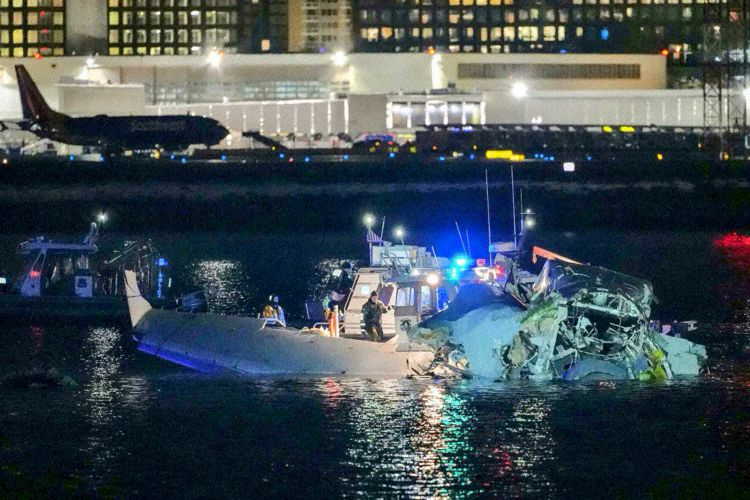Overview
• Operator: PSA Airlines on behalf of American Airlines
• Aircraft Model: Bombardier CRJ-700
• Registration: N709PS
• Flight Number: AA-5342
• Route: Wichita (Kansas) → Washington National (D.C.), USA
• Date: 29 January 2025
• Occupants: 64 (60 passengers, 4 crew)
• Second Aircraft:
• Operator: U.S. Army
• Aircraft Model: Sikorsky UH-60 Black Hawk
• Call Sign: PAT25
• Route: Training flight transitioning between helicopter routes 1 and 4
• Occupants: 3 crew
• Total Fatalities: 67 (all on board both aircraft)
• Nature of Incident: Midair collision on final approach
Incident Summary
On 29 January 2025, PSA Airlines flight AA-5342, a Bombardier CRJ-700, was on final approach to runway 33 at Washington National Airport (DCA) when it collided midair with a U.S. Army Sikorsky UH-60 Black Hawk helicopter. The impact occurred approximately 0.6 nautical miles from the runway threshold at an altitude of around 200-325 feet AGL.
Both aircraft plunged into the Potomac River. There were no survivors.
A large-scale emergency response was launched, but due to frigid water temperatures, survival time for anyone in the river was estimated at 15-90 minutes. By the morning of 30 January 2025, officials had recovered 28 bodies, and the search operation transitioned into recovery mode.
Sequence of Events
Approach Phase & Clearance to Runway 33
• The CRJ-700 was originally cleared for runway 01.
• The tower asked the crew if they could land on runway 33 instead, to which they agreed.
• The aircraft was subsequently cleared for landing on runway 33.
• The CRJ crew received a Traffic Advisory (TA) from their TCAS system but continued the approach.
Collision with the Black Hawk Helicopter
• The helicopter was transitioning between helicopter routes 1 and 4.
• At 01:46Z, the CRJ-700 was descending through approximately 200-325 feet AGL when the aircraft and helicopter collided.
• The PSA jet rolled beyond 90 degrees and became belly-up, before impacting the Potomac River.
Immediate Aftermath
• The Washington National ATC tower witnessed the collision.
• All approaches were ordered to go around, and departures were halted.
• Airport closed until 31 January 2025 at 05:00 local time.
• Military helicopters and boats were dispatched for rescue operations, but by the morning of 30 January, the operation shifted to recovery.
Investigation & NTSB Findings
Black Box Recoveries
• 31 January 2025:
• Both black boxes (Cockpit Voice Recorder & Flight Data Recorder) from the CRJ-700 recovered.
• The combined CVR/DFDR from the Black Hawk also recovered.
• 1 February 2025:
• Full FDR download completed for the CRJ-700.
• CVR suffered water damage but contained 124 minutes of usable audio.
• ATC transcripts confirmed the CRJ was cleared for runway 33 and had received a TCAS advisory before impact.
Altitude Discrepancies
• The CRJ-700’s FDR data showed an altitude of 325 feet ± 25 feet MSL at impact.
• The tower radar display at Washington National showed the Black Hawk at 300 feet (rounded to the nearest 100 feet).
• The Potomac TRACON radar fused multiple data sources, showing both aircraft at similar altitudes prior to impact.
Black Hawk Data Recovery Delay
• 4 February 2025: The NTSB suspended on-scene media briefings pending full recovery of the Black Hawk from the river.
• The Black Hawk’s precise altitude, visibility, and use of night vision goggles remain under investigation.
Eyewitness Reports & Analysis
• Eyewitnesses described sparks and fire before the CRJ-700 rolled belly-up and plunged into the water.
• Surveillance footage & ATC radar confirm that the helicopter was within its designated route, but altitude discrepancies remain under review.
• The CRJ-700 increased pitch roughly one second before impact, indicating that the crew may have attempted to avoid the collision at the last moment.
Key Questions Under Investigation
1. Did the air traffic controller miscalculate the separation between the aircraft and helicopter?
2. Was the helicopter operating within its assigned altitude limits?
3. Did the CRJ crew visually identify the helicopter before impact?
4. Was the Black Hawk crew using night vision equipment?
5. Did TCAS advisories on the CRJ provide sufficient warning?
6. Was there a breakdown in coordination between Washington National Tower and Potomac TRACON?
Implications & Safety Concerns
• Airspace conflicts between fixed-wing and rotary-wing aircraft require urgent review.
• Coordination between military and civilian ATC operations must be improved, particularly in high-density urban airspace.
• Potential procedural changes for runway reassignments on final approach may be recommended.
• Enhanced TCAS resolution advisories for low-altitude conflicts should be explored.
Disclaimer
This report is based on available information as of 4 February 2025. While every effort has been made to ensure accuracy, the completeness of the details cannot be guaranteed. If you are the rightful owner of any referenced materials and wish them removed, please email takedown@cockpitking.com.
